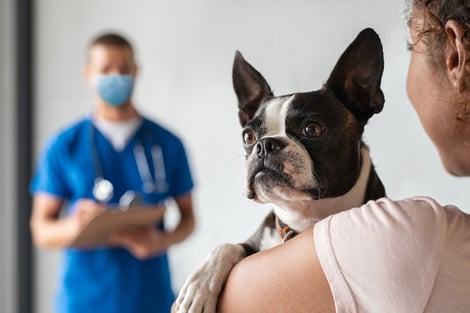How to Know When to Take Your Dog or Cat to the Vet

Keeping pets happy and healthy are our biggest jobs as pet owners and as the humans in their lives. Although pets are not able to verbally express themselves when they aren’t feeling well, pet parents may notice a difference in their dog or cat if they are in pain or experiencing distress.
How Proper Timing Can Save Money
It may be tempting to wait until your pet’s symptoms worsen to avoid a big veterinary bill. However, many times waiting too long can lead to higher bills and may put your pet at greater risk of pain and even death. Veterinarians can offer a range of recommended treatment plans to create less stress during what can be an anxious time. This helps pet parents to make smart financial decisions while also prioritizing their pets’ care.
Most often, veterinarians will offer “gold standard” care options first, which include all the recommended tests that can best pinpoint the problem. It’s easiest to make an accurate diagnosis with the proper tests. Sometimes the cost of those tests might be more than you can afford. Tell your veterinarian if you need to preserve your budget for what might be the most likely cause of what ails your pet so that you can pay for treatments that might help. If you follow those treatment plans exactly and they don’t work, then you’ll need to come back with your pet for another vet visit.
It’s best for your budget to stick with one veterinary clinic for your pet’s problems. Switching veterinary clinics can lead to higher costs since another clinic may ask to repeat tests for a recent health problem, which might not be needed if you stay with the same clinic.
There may also be payment options or programs available to help with these costs:
- Pet insurance allows you to find coverage that best fits the needs of your family. You can search the NAPHIA website to view many options from which to choose, including Cleveland‑based Embrace Pet Insurance.
- The CareCredit program which, after a short five‑minute application process, allows you to break down your payment into six monthly installments. You must pay on time or risk heavy fees.
- Find a veterinary clinic that has agreed to accept Vouchers as payment from our One Health Family Members.
When in doubt about your pet’s health, reach out to your local veterinarian and get their advice. They may advise a visit just to make sure everything’s okay.
Signs You Should Take Your Pet to the Veterinarian
Here are a few common signs that it’s time to take your pet to the vet.
Change in Eating Habits
Any significant change in your dog or cat’s eating habits may indicate a larger issue. Skipping one meal is probably okay, especially if they are in a new environment, but not eating for two days is a sign of potential trouble.
The opposite is also true: if your dog or cat is trying to increase access to food by raiding the cupboards or refrigerator, you should contact a vet.
Change in Thirst
It’s normal for rigorous exercise or a walk to leave your pet extra thirsty. However, excessive thirst could be a possible sign of kidney disease or diabetes.
Not drinking enough water can lead to digestive problems.
So if your pet is drinking more or less than normal, then it’s time to call your vet.
Eye Appearance
The eyes are a window into dogs’ and cats’ health. Infections can make your pet’s eyes look red or cloudy. They can also cause unusual discharge. If you see any of these symptoms, act quickly because eye disease can progress quickly.
Squinting or pawing at one eye could indicate an injury, which would also need to be examined by a vet.
Change in Stool
Keep an eye out for any changes in your pet’s poo. Generally, healthy poop is firm and moist. Dark and dry poop or trouble defecating can be signs of dehydration, dietary illness, or other issues. If you see any worms in the stool, make an appointment right away. There are effective treatments that are life‑saving.
Other changes to look for are blood or mucus that’s present for longer than 24 hours. Contact your vet right away if you notice these symptoms for a few days straight.
Vomiting
On occasion, dogs and cats will throw up food that doesn’t agree with their digestive system, much as humans do. It’s less concerning for a pet to throw up two or three times in 10 minutes in only one day. However, if the vomiting becomes chronic — say, two or three times over the course of several hours — it’s time to contact your vet to book an appointment.
If you notice vomiting in addition to any other symptoms like lethargy or diarrhea, contact your veterinarian immediately.
Lethargy
Is your normally energetic dog or cat doing fewer zooms around your home? Are they less interested in walks or not responding to calls? That could be a sign that your pet is ill or has a physical injury that’s hurting them and making playtime painful. Your veterinarian can help you find out if it’s a normal aging process or if something more serious is happening.
Signs of an Emergency
There are some problems that require immediate attention. If you notice any of these symptoms, contact your veterinarian as quickly as possible:
- Open wounds, broken bones, or injury due to trauma
- Stopped breathing or unconsciousness
- Seizure or seizure‑like activities
- Sudden collapse or difficulty breathing
- Bleeding from mouth, nose, or ears
- Possible poisoning from something toxic
- Extreme pain, displaying by whining or shaking or biting at familiar family members for no apparent reason
- Scratching or licking (excessive, frequently, or for a long period of time in a single day; ears or other parts of the body)
Knowing your pet’s habits, behaviors, and routines, along with other information about their breed, helps when looking for health issues. Trust your instincts, and always reach out to your local vet if you have questions or concerns.

